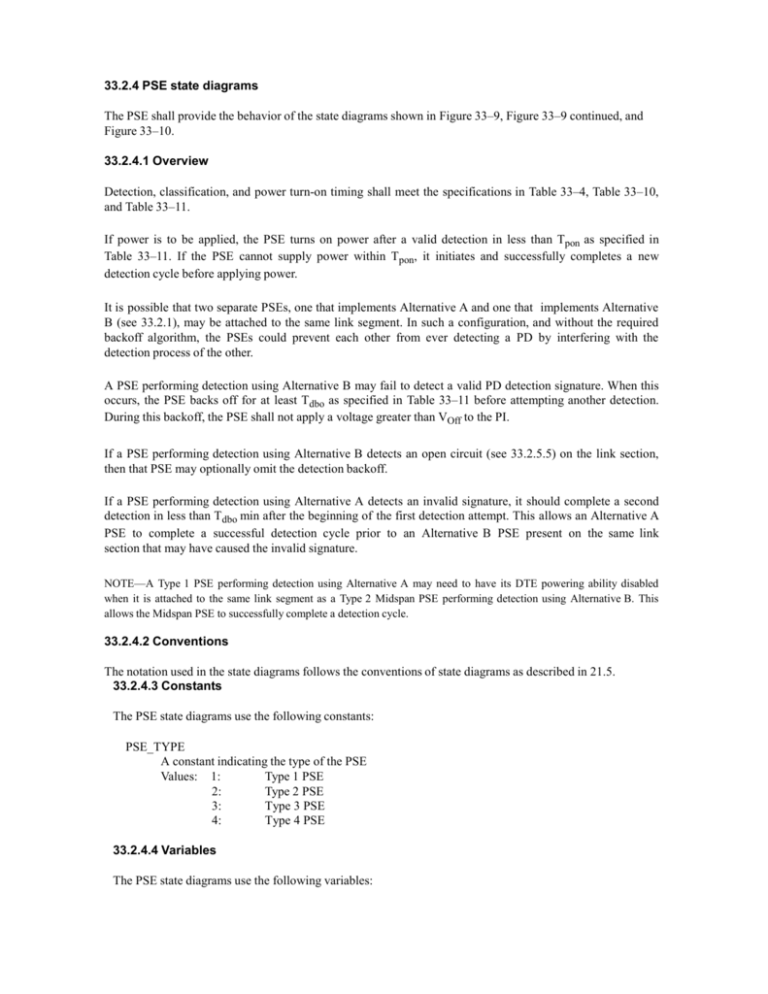
33.2.4 PSE state diagrams
The PSE shall provide the behavior of the state diagrams shown in Figure 33–9, Figure 33–9 continued, and
Figure 33–10.
33.2.4.1 Overview
Detection, classification, and power turn-on timing shall meet the specifications in Table 33–4, Table 33–10,
and Table 33–11.
If power is to be applied, the PSE turns on power after a valid detection in less than Tpon as specified in
Table 33–11. If the PSE cannot supply power within Tpon, it initiates and successfully completes a new
detection cycle before applying power.
It is possible that two separate PSEs, one that implements Alternative A and one that implements Alternative
B (see 33.2.1), may be attached to the same link segment. In such a configuration, and without the required
backoff algorithm, the PSEs could prevent each other from ever detecting a PD by interfering with the
detection process of the other.
A PSE performing detection using Alternative B may fail to detect a valid PD detection signature. When this
occurs, the PSE backs off for at least Tdbo as specified in Table 33–11 before attempting another detection.
During this backoff, the PSE shall not apply a voltage greater than VOff to the PI.
If a PSE performing detection using Alternative B detects an open circuit (see 33.2.5.5) on the link section,
then that PSE may optionally omit the detection backoff.
If a PSE performing detection using Alternative A detects an invalid signature, it should complete a second
detection in less than Tdbo min after the beginning of the first detection attempt. This allows an Alternative A
PSE to complete a successful detection cycle prior to an Alternative B PSE present on the same link
section that may have caused the invalid signature.
NOTE—A Type 1 PSE performing detection using Alternative A may need to have its DTE powering ability disabled
when it is attached to the same link segment as a Type 2 Midspan PSE performing detection using Alternative B. This
allows the Midspan PSE to successfully complete a detection cycle.
33.2.4.2 Conventions
The notation used in the state diagrams follows the conventions of state diagrams as described in 21.5.
33.2.4.3 Constants
The PSE state diagrams use the following constants:
PSE_TYPE
A constant indicating the type of the PSE
Values: 1:
Type 1 PSE
2:
Type 2 PSE
3:
Type 3 PSE
4:
Type 4 PSE
33.2.4.4 Variables
The PSE state diagrams use the following variables:
class_num_events
A variable indicating the maximum number of classification events performed by the PSE. A
variable that is set in an implementation-dependent manner.
Values: 0:
PSE does not perform Physical Layer classification.
1:
PSE performs 1-Event Physical Layer classification.
2:
PSE performs Mulitple-Event Physical Layer classification with a maximum of
2 class events.
4:
PSE performs Multiple-Event Physical Layer classification with a maximum of
4 class events.
5:
PSE performs Multiple-Event Physical Layer classification with a maximum of
5 class events.
error_condition
A variable indicating the status of implementation-specific fault conditions or optionally other
system faults that prevent the PSE from meeting the specifications in Table 33–11 and that require
the PSE not to source power. These error conditions are different from those monitored by the state
diagrams in Figure 33–10.
Values: FALSE: No fault indication.
TRUE: A fault indication exists.
IInrush
Output current during POWER_UP (see Table 33–11 and Figure 33–13).
IPort
Output current (see 33.2.7.6).
legacy_powerup
This variable is provided for PSEs that monitor the PI voltage output and use that information to
indicate the completion of PD inrush current during POWER_UP operation. Using only the PI
voltage information may be insufficient to determine the true end of PD inrush current; use of a
fixed TInrush period is recommended. A variable that is set in an implementation-dependent
manner.
Values: TRUE: The PSE supports legacy power up; this value is not recommended.
FALSE: The PSE does not support legacy power up. It is highly recommended that
new equipment use this value.
mr_mps_valid
The PSE monitors either the DC or AC Maintain Power Signature (MPS, see 33.2.9.1). This
variable indicates the presence or absence of a valid MPS.
Values: FALSE: If monitoring both components of the MPS, the DC component of MPS is
absent or the AC component of MPS is absent. If monitoring only one
component of MPS, that component of MPS is absent.
TRUE:
If monitoring both components of the MPS, the DC component of MPS and
the AC component of MPS are both present. If monitoring only one
component of MPS, that component of MPS is present.
mr_pse_alternative
This variable indicates which Pinout Alternative the PSE uses to apply power to the link (see Table
33–2). This variable is provided by a management interface that may be mapped to the PSE
Control register Pair Control bits (11.3:2) or other equivalent function.
Values: A: The PSE uses PSE pinout Alternative A.
B: The PSE uses PSE pinout Alternative B.
A & B: PSE uses PSE pinout Alternative A and Alternative B
mr_pse_enable
A control variable that selects PSE operation and test functions. This variable is provided by a
management interface that may be mapped to the PSE Control register PSE Enable bits (11.1:0), as
described below, or other equivalent functions.
Values: disable:
All PSE functions disabled (behavior is as if there was no PSE
functionality). This value corresponds to MDIO register bits 11.1:0 =
'00'.
enable:
Normal PSE operation. This value corresponds to MDIO register bits
11.1:0 = '01'.
force_power: Test mode selected that causes the PSE to apply power to the PI when
there are no detected error conditions. This value corresponds to MDIO
register bits 11.1:0 = '10'.
option_detect_ted
This variable indicates if detection can be performed by the PSE during the ted_timer interval.
Values: FALSE: Do not perform detection during ted_timer interval.
TRUE: Perform detection during ted_timer interval.
option_vport_lim
This optional variable indicates if VPSE is out of the operating range during normal operating state.
Values: FALSE: VPSE is within the VPort_PSE operating range as defined in Table 33–11.
TRUE: VPSE is outside of the VPort_PSE operating range as defined in Table 33–11.
ovld_detected
A variable indicating if the PSE output current has been in an overload condition (see 33.2.7.6) for
at least TCUT of a one second sliding time.
Values: FALSE: The PSE has not detected an overload condition.
TRUE: The PSE has detected an overload condition.
pd_dll_power_type
A control variable output by the PSE power control state diagram (Figure 33–27) that indicates the
type of PD as advertised through Data Link Layer classification.
Values: 1:
PD is a Type 1 PD (default)
2:
PD is a Type 2 PD
3:
PD is a Type 3
PD4:
PD is a Type 4 PD
pi_powered
A variable that controls the circuitry that the PSE uses to power the PD.
Values: FALSE: The PSE is not to apply power to the link (default).
TRUE: The PSE has detected a PD, classified it if applicable, and determined the PD
is to be powered; or power is being forced on in TEST_MODE.
power_applied
A variable indicating that the PSE has begun steady state operation by having asserted pi_powered,
completed the ramp of voltage, is not in a current limiting mode, and is operating beyond the
POWER_UP requirements of 33.2.7.5.
Values: FALSE: The PSE is either not applying power or has begun applying power but is still
in POWER_UP.
TRUE: The PSE has begun steady state operation.
power_not_available
Variable that is asserted in an implementation-dependent manner when the PSE is no longer
capable of sourcing sufficient power to support the attached PD. Sufficient power is defined by
classification; see 33.2.6.
Values: FALSE: PSE is capable to continue to source power to a PD.
TRUE: PSE is no longer capable of sourcing power to a PD.
pse_available_power
This variable indicates the highest power PD Class that could be supported. The value is
determined in an implementation-specific manner.
Values: 0:
Class 1
1:
Class 2
2:
Class 0 and Class 3
3:
Class 4
4:
Class 5
5:
Class 6
6:
Class 7
pse_dll_capable
This variable indicates whether the PSE is capable of performing optional Data Link Layer
classification. See 33.6. This variable is provided by a management interface that may be mapped
to the PSE Control register Data Link Layer Classification Capability bit (11.5), as described
below, or other equivalent functions. A variable that is set in an implementation-dependent
manner.
Values:
FALSE:
TRUE:
The PSE’s Data Link Layer classification capability is not enabled.
The PSE’s Data Link Layer classification capability is enabled.
pse_dll_enabled
A variable indicating whether the Data Link Layer classification mechanism is enabled. See 33.6.
Values: FALSE: Data Link Layer classification is not enabled.
TRUE: Data Link Layer classification is enabled.
pse_ready
Variable that is asserted in an implementation-dependent manner to probe the link segment.
Values: FALSE: PSE is not ready to probe the link segment.
TRUE: PSE is ready to probe the link segment.
NOTE—Care should be taken when negating this variable in a PSE performing detection using Alternative A after an
invalid signature is detected due to the delay it introduces between detection attempts (see 33.2.4.1).
pse_reset
Controls the resetting of the PSE state diagram. Condition that is TRUE until such time as the
power supply for the device that contains the PSE overall state diagrams has reached the operating
region. It is also TRUE when implementation-specific reasons require reset of PSE functionality.
Values: FALSE: Do not reset the PSE state diagram.
TRUE: Reset the PSE state diagram.
pse_skips_multiclass
The PSE can choose to bypass a portion of the classification state flow. A variable that is set in an
implementation-dependent manner.
Values: FALSE: The PSE does not bypass MARK_EV1 and all subsequent mark and class
states.
TRUE: The PSE does bypass MARK_EV1 and all subsequent mark and class states.
short_detected
A variable indicating if the PSE output current has been in a short circuit condition for TLIM within
a sliding window (see 33.2.7.7).
Values: FALSE: The PSE has not detected a short circuit condition.
TRUE: The PSE has detected qualified short circuit condition.
temp_var
A temporary variable used to store the value of the state variable mr_pd_class_detected.
PSEs shall meet at least one of the allowable variable definition permutations described in Table 33–3.
Table 33–3—Allowed PSE variable definition permutations
Variables
PSE Type
class_num_events
5
Type 4
pse_dll_capable
FALSE
TRUE
1
4
TRUE
FALSE
TRUE
Type 3
2
FALSE2
TRUE
1
FALSE1
TRUE
FALSE
2
TRUE
Type 2
1
TRUE
FALSE
1
TRUE
Type 1
FALSE
0
TRUE
Note 1—A Type 3 PSE with a guaranteed power
output of 15.4W or less can be limited to one class
event without requiring dll capability.
Note 2—A Type 3 PSE with a guaranteed power
output of 30W or less can be limited to two class
events without requiring dll capability.
33.2.4.5 Timers
All timers operate in the manner described in 14.2.3.2 with the following addition: a timer is reset and stops
counting upon entering a state where “stop x_timer” is asserted.
tcle1_timer
A timer used to limit the first classification event time in Multiple-Event classification for Type
1 and Type 2 PSEs; see TCLE1 in Table 33–10.
tcle2_timer
A timer used to limit the second classification event time in Multiple-Event classification; see
TCLE2 in Table 33–10.
tcle3_timer
A timer used to limit the third through fifth classification event time in Multiple Event
classification; see TCLE3 in Table 33–10.
tlcf_timer
A timer used to limit the first classification event time in Multiple-Event classification for Type 3
and Type 4 PSEs; see TLCF in Table 33–10.
tdbo_timer
A timer used to regulate backoff upon detection of an invalid signature; see Tdbo in Table 33–11.
tdet_timer
A timer used to limit an attempt to detect a PD; see Tdet in Table 33–11.
ted_timer
A timer used to regulate a subsequent attempt to power a PD after an error condition causes power
removal; see Ted in Table 33–11. The default state of this timer is ted_timer_done.
tinrush_timer
A timer used to monitor the duration of the inrush event; see TInrush in Table 33–11.
tme1_timer
A timer used to limit the first mark event time in Multiple-Event classification; see TME1 in Table
33–10.
tme2_timer
A timer used to limit the final mark event time in Multiple-Event classification; see TME2 in Table
33–10.
tmpdo_timer
A timer used to monitor the dropout of the MPS; see TMPDO in Table 33–11.
tpdc_timer
A timer used to limit the classification time; see Tpdc in Table 33–10.
tpon_timer
A timer used to limit the time for power turn-on; see Tpon in Table 33–11.
33.2.4.6 Functions
do_classification
This function returns the following variables:
pd_requested_power: This variable indicates the power class requested by the PD. A Type 1 PSE
that measures a Class 4 signature assigns that PD to Class 0. See 33.2.6.
Values:
0:
Class 1
1:
Class 2
2:
Class 0 or Class 3
3:
Class 4
4:
5:
Class 5 (mr_pd_class_detected will have a value of 4 for the first two
class events and a value of ‘1’ for any subsequent class events)
Class 6 (mr_pd_class_detected will have a value of 4 for the first two
class events and a value of ‘2’ for any subsequent class events)
Copyright © 2012 IEEE. All rights reserved.
6
6:
Class 7 (mr_pd_class_detected will have a value of 4 for the first two
class events and a value of ‘3’ for any subsequent class events)
mr_pd_class_detected: The PD classification signature seen during a classification event; see
Table 33–7 and 33.2.6.
Values:
0:
Class 0
1:
Class 1
2:
Class 2
3:
Class 3
4:
Class 4
do_detection
This function returns the following variables:
signature:
This variable indicates the presence or absence of a PD.
Values:
open_circuit:
The PSE has detected an open circuit. This value is optionally
returned by a PSE performing detection using Alternative B.
valid:
The PSE has detected a PD requesting power.
invalid:
Neither open_circuit, nor valid PD detection signature has been
found.
mr_valid_signature:
This variable indicates that the PSE has detected a valid signature.
Values:
FALSE:
No valid signature detected.
TRUE:
Valid signature detected.
do_mark
This function produces the classification mark event voltage. This function does not return any
variables.
set_parameter_type
This function is used by a Type 2, Type 3, or Type 4 PSE to evaluate the type of PD connected to
the link based on Physical Layer classification or Data Link Layer classification results. The
PSE’s PI electrical requirements defined in Table 33–11 are set to values corresponding to either
a Type 1, Type 2, Type 3, or Type 4 PSE. This function returns the following variable:
parameter_type: A variable used by a Type 2 PSE, Type 3 PSE, or Type 4 PSE to pick between
Type 1, Type 2, Type 3, and Type 4 PI electrical requirement parameter values defined in Table
33–11.
Values:
1:
Type 1 PSE parameter values (default)
2:
Type 2 PSE parameter values
3:
Type 3 PSE parameter values
4:
Type 4 PSE parameter values
When a Type 2 PSE powers a Type 2, Type 3, or Type 4 PD, the PSE may choose to assign
a value of ‘1’ to parameter_type if mutual identification is not complete (see 33.2.6) and shall
assign a value of ‘2’ to parameter_type if mutual identification is complete. When a Type 3 PSE
powers a Type 2, Type 3, or Type 4 PD, the PSE may choose to assign a value of ‘1’ or ‘2’ to
parameter_type if mutual identification is not complete (see 33.2.6) and shall assign a value of ‘3’
to parameter type if mutual identification is complete. When a Type 4 PSE powers a Type 2, Type
3, or Type 4 PD, the PSE may choose to assign a value of ‘1’, ‘2’, or ‘3’ to parameter_type if
mutual identification is not complete (see 33.2.6) and shall assign a value of ‘4’ to parameter type
if mutual identification is complete.
When a Type 2 PSE powers a Type 1 PD, the PSE shall meet the PI electrical requirements of a
Type 1 PSE, but may choose to meet the electrical requirements of a Type 2 PSE for ICon, ILIM,
TLIM, and PType (see Table 33–11).
Copyright © 2012 IEEE. All rights reserved.
7
When a Type 3 PSE powers a Type 1 PD, the PSE shall meet the PI electrical requirements of a
Type 1 PSE, but may choose to meet the electrical requirements of a Type 2 or Type 3 PSE for
ICon, ILIM, TLIM, and PType , IInrush , ICUT (see Table 33–11).
When a Type 3 PSE powers a Type 2 PD, the PSE shall meet the PI electrical requirements of a
Type 2 PSE, but may choose to meet the electrical requirements of a Type 3 PSE for ICon, ILIM,
TLIM, and PType , IInrush , ICUT (see Table 33–11).
When a Type 4 PSE powers a Type 1 PD, the PSE shall meet the PI electrical requirements of a
Type 1 PSE, but may choose to meet the electrical requirements of a Type 2, Type 3, or Type 4
PSE for ICon, ILIM, TLIM, and PType , IInrush , ICUT (see Table 33–11).
When a Type 4 PSE powers a Type 2 PD, the PSE shall meet the PI electrical requirements of a
Type 2 PSE, but may choose to meet the electrical requirements of a Type 3 or Type 4 PSE for
ICon, ILIM, TLIM, and PType , IInrush , ICUT (see Table 33–11).
When a Type 4 PSE powers a Type 3 PD, the PSE shall meet the PI electrical requirements of a
Type 3 PSE, but may choose to meet the electrical requirements of a Type 4 PSE for ICon, ILIM,
TLIM, and PType , IInrush , ICUT (see Table 33–11).
Copyright © 2012 IEEE. All rights reserved.
8
NOTE: This State Diagram is only representative of a single classification algorithm (single PD).
Figure 33–9—PSE state diagram (continued)
Copyright © 2012 IEEE. All rights reserved.
9
33.2.6 PSE classification of PDs and mutual identification
The ability for the PSE to query the PD in order to determine the power requirements of that PD is called
classification. The interrogation and power classification function is intended to establish mutual
identification and is intended for use with advanced features such as power management.
Mutual identification is the mechanism that allows a Type 2, Type 3, or Type 4 PD to differentiate
between Type 1, Type 2, Type3, and Type4 PSEs. Additionally, mutual identification allows a Type 2, Type
3, o r T yp e 4 PSE to differentiate between Type 1, Type 2, Type 3, and Type 4 PDs. PDs or PSEs that do
not implement classification will not be able to complete mutual identification and can only perform as Type 1
devices.
There are two forms of classification: Physical Layer classification and Data Link Layer classification.
Physical Layer classification occurs before a PSE supplies power to a PD when the PSE asserts a voltage
onto the PI and the PD responds with a current representing a limited number of power classifications.
Based on the response of the PD, the minimum power level at the output of the PSE is PClass as shown in
Equation (33–3). Physical Layer classification encompasses two methods, known as 1-Event Physical Layer
classification (see 33.2.6.1) and Multiple-Event Physical Layer classification (see 33.2.6.2).
The minimum power output by the PSE for a particular PD class is defined by Equation (33–3).
Alternatively, PSE implementations may use VPSE = VPort_PSE min and RChan = RCh max to arrive at overmargined values as shown in Table 33–7.
–
⎛
⎧
×
=
P Class
⎨ V PSE
⎩
V PSE
2
–4×R
×P
⎞⎫
V PSE
----------------------C---h--a--n------------C---l-a--s--s-_--P---D-
⎜ -----------------------------2×R
⎝
Chan
⎟⎬
⎠ ⎭W
(33–3)
where
VPSE
RChan
PClass_PD
is the voltage at the PSE PI as defined in 1.4
is the channel DC pair loop resistance
is the PD’s power classification (see Table 33–18)
Copyright © 2012 IEEE. All rights reserved.
10
Table 33–7—Physical Layer power classifications (PClass)
Class
Minimum power levels at
output of PSE (PClass)
0
15.4 Watts
1
4.00 Watts
2
7.00 Watts
3
15.4 Watts
4
30W or PType as defined in
Table 33–11, whichever is less
5 (4/4/1)
45W or PType as defined in
6 (4/4/2)
Table 33–11, whichever is less
60W or PType as defined in
7 (4/4/3)
Table 33–11, whichever is less
PType as defined in
Table 33–11
NOTE 1—This is the minimum power at the PSE PI. For
maximum power available to PDs, see Table 33–18.
NOTE 2—Data Link Layer classification takes precedence
over Physical Layer classification.
With Data Link Layer classification, the PSE and PD communicate using the Data Link Layer Protocol (see
33.6) after the data link is established. The Data Link Layer classification has finer power resolution and the
ability for the PSE and PD to participate in dynamic power allocation wherein allocated power to the PD
may change one or more times during PD operation.
A PSE shall meet one of the allowable classification permutations listed in Table 33–8.
Subsequent to successful detection, a Type 1 PSE may optionally classify a PD using 1-Event Physical
Layer classification. Valid classification results are Classes 0, 1, 2, 3, and 4, as listed in Table 33–7. If a
Type 1 PSE does not implement classification, then the Type 1 PSE shall assign all PDs to Class 0. A Type 1
PSE may optionally implement Data Link Layer classification.
Copyright © 2012 IEEE. All rights reserved.
11
Table 33–8—PSE and PD classification permutations
Permutations
PSE/PD
Type
Physical Layer
classification
Data Link Layer
classification
PSE
allowed?
PD
allowed?
No
Yes
No
Yes
Yes
Yes
No
No1
No
Yes
Yes
No
No
No
No
Yes
No
No
No
No
Yes
Yes
No
Yes
No
Yes
Yes
Yes
Yes
Yes
No
Yes
No
Yes
Yes
No
Multiple-Event
Type 2,
Type 3, or 1-Event
Type 4
None
Multiple-Event
Type 1
1-Event
None
NOTE 1—A Type 3 PSE that is limited to Type 1 power levels can be limited to 1-Event Physical Layer
classification without required DLL capability.
Subsequent to successful detection, all Type 2, Type 3, and Type 4 PSEs perform classification using at
least one of the following: Multiple-Event Physical Layer classification; Multiple-Event Physical Layer
classification and Data Link Layer classification; or 1-Event Physical Layer classification and Data Link Layer
classification.
If a PSE successfully completes detection of a PD, but the PSE fails to complete classification of a PD, then a
Type 1 PSE shall either return to the IDLE state or assign the PD to Class 0; a Type 2, Type 3, or Type 4
PSE shall return to the IDLE state.
33.2.6.1 PSE 1-Event Physical Layer classification
When 1-Event Physical Layer classification is implemented, classification consists of the application of
VClass and the measurement of IClass in a single classification event—1-EVENT_CLASS—as defined in the
state diagram in Figure 33–9.
The PSE shall provide to the PI VClass with a current limitation of IClass_LIM, as defined in Table 33–10.
Polarity shall be the same as defined for VPort_PSE in 33.2.3 and timing specifications shall be as defined by
Tpdc in Table 33–10.
The PSE shall measure the resultant IClass and classify the PD based on the observed current according to
Table 33–9. All measurements of IClass shall be taken after the minimum relevant class event timing in Table
33–10. This measurement is referenced from the application of VClass min to ignore initial transients.
If the result of the class event is Class 4, a Type 1 PSE shall assign the PD to Class 0; a Type 2, Type 3, or Type
4 PSE treats the PD as a Type 2 PD but may provide Class 0 power until mutual identification is complete.
Copyright © 2012 IEEE. All rights reserved.
12
If the measured IClass is within the range of IClass_LIM, a Type 1 PSE shall either return to the IDLE state or
classify the PD as Class 0; a Type 2, Type 3, or Type 4 PSE shall return to the IDLE state.
Copyright © 2012 IEEE. All rights reserved.
13
33.2.6.2 PSE Multiple-Event Physical Layer classification
When Multiple-Event Physical Layer classification is implemented, classification consists of the application of
VClass and the measurement of IClass in a series of classification and mark events—CLASS_EV1, MARK_EV1,
CLASS_EV2, MARK_EV2, CLASS_EV3, MARK_EV3, CLASS_EV4, MARK_EV4, CLASS_EV5, and
MARK_EV_LAST—as defined in the state diagram in Figure 33–9.
Type 2 PSEs shall provide a maximum of 2 class and 2 mark events. Type 3 PSEs shall provide a maximum of 4
class and 4 mark events. Type 4 PSEs shall provide a maximum of 5 class and 5 mark events.
A PSE in the state CLASS_EV1 shall provide to the PI VClass as defined in Table 33–10. The timing
specification shall be as defined by TCLE1 in Table 33–10 The PSE shall measure IClass and classify the PD based on
the observed current according to Table 33–TBDA1.
A PSE in the state CLASS_EV1_LCF shall provide to the PI VClass as defined in Table 33–10. The timing
specification shall be as defined by TLCF in Table 33–10. The PSE shall measure IClass and classify the PD based on
the observed current according to Table 33–TBDA1.
When the PSE is in the state MARK_EV1, the PSE shall provide to the PI VMark as defined in Table 33–10. The
timing specification shall be as defined by TME1 in Table 33–10.
When the PSE is in the state CLASS_EV2, the PSE shall provide to the PI VClass, subject to the TCLE2 timing
specification, as defined in Table 33–10. The PSE shall measure IClass and classify the PD based on the observed
current according to Table 33–TBDA1.
When the PSE is in the state MARK_EV2, the PSE shall provide to the PI VMark as defined in Table 33–10. The
timing specification shall be as defined by TME1 in Table 33–10.
When the PSE is in the state CLASS_EV3, the PSE shall provide to the PI VClass, subject to the TCLE3 timing
specification, as defined in Table 33–10. The PSE shall measure IClass and classify the PD based on the observed
current according to Table 33–TBDA1.
When the PSE is in the state MARK_EV3, the PSE shall provide to the PI VMark as defined in Table 33–10. The
timing specification shall be as defined by TME1 in Table 33–10.
When the PSE is in the state CLASS_EV4, the PSE shall provide to the PI VClass, subject to the TCLE3 timing
specification, as defined in Table 33–10. The PSE shall measure IClass and classify the PD based on the observed
current according to Table 33–TBDA1.
When the PSE is in the state MARK_EV4, the PSE shall provide to the PI VMark as defined in Table 33–10. The
timing specification shall be as defined by TME1 in Table 33–10.
When the PSE is in the state CLASS_EV5, the PSE shall provide to the PI VClass, subject to the TCLE3 timing
specification, as defined in Table 33–10. The PSE shall measure IClass and classify the PD based on the observed
current according to Table 33–TBDA1.
When the PSE is in the state MARK_EV_LAST, the PSE shall provide to the PI VMark as defined in Table 33–10.
The timing specification shall be as defined by TME2 in Table 33–10.
Copyright © 2012 IEEE. All rights reserved.
14
The mark event states, MARK_EV1, MARK_EV2, MARK_EV3, MARK_EV4, and MARK_EV_LAST,
commence when the PI voltage falls below VClass min and end when the PI voltage exceeds VClass min. The VMark
requirement is to be met with load currents in the range of IMark as defined in Table 33–17.
NOTE—In a properly operating system, the port may or may not discharge to the VMark range due to the combination of channel
and PD capacitance and PD current loading. This is normal and acceptable system operation. For compliance testing, it is
necessary to discharge the port in order to observe the VMark voltage. Discharge can be accomplished with a
2 mA load for 3 ms, after which VMark can be observed with minimum and maximum load current.
If any measured IClass is equal to or greater than IClass_LIM min as defined in Table 33–10, a Type 2, Type3, or
Type4 PSE shall return to the IDLE state. The class events shall meet the IClass_LIM current limitation. The mark
events shall meet the IMark_LIM current limitation. All measurements of IClass shall be taken after the minimum
relevant class event timing of Table 33–10. This measurement is referenced from the application of VClass
min to ignore initial transients.
All class event voltages and mark event voltages shall have the same polarity as defined for VPort_PSE in
33.2.3. The PSE shall complete Multiple-Event Physical Layer classification and transition to the POWER_ON
state without allowing the voltage at the PI to go below VMark min. If the PSE returns to the IDLE state, it shall
maintain the PI voltage at VReset for a period of at least TReset min before starting a new detection cycle.
If the result of the first class event is Class 4, the PSE may omit the subsequent mark and class events only if the PSE
implements Data Link Layer classification. In this case, a Type 2, Type 3, or Type 4 PSE treats the PD as a Type 2
PD but may provide Class 0 power until mutual identification is complete.
If the result of the first class event is any of Classes 0, 1, 2, or 3, a Type 2 PSE treats the PD as a Type 1 PD and
may omit the subsequent mark and class events and classify the PD according to the result of the first class event. If
the result of the first class event is any of Classes 0, 1, 2, or 3, a Type 3 or Type 4 PSE treats the PD as a Type 1
PD and shall omit the subsequent mark and class events and classify the PD according to the result of the first class
event.
A Type 3 or Type 4 PSE shall skip all subsequent class events and transition directly to Mark_EV_LAST if
the class signature detected during CLASS_EV3 is 4. A Type 4 PSE shall skip MARK_EV_4 and
CLASS_EV5 and transition directly to Mark_EV_LAST if the class signature detected during CLASS_EV4 is
1 or 2
Copyright © 2012 IEEE. All rights reserved.
15
Table 33–9—PD classification
Measured IClass
Classification
0 mA to 5.00 mA
Class 0
> 5.00 mA and < 8.00 mA
May be Class 0 or 1
8.00 mA to 13.0 mA
Class 1
> 13.0 mA and < 16.0 mA
Either Class 1 or 2
16.0 mA to 21.0 mA
Class 2
> 21.0 mA and < 25.0 mA
Either Class 2 or 3
25.0 mA to 31.0 mA
Class 3
> 31.0 mA and < 35.0 mA
Either Class 3 or 4
35.0 mA to 45.0 mA
Class 4
> 45.0 mA and < 51.0 mA
Either Class 4 or invalid class
NOTE—A Type 1 PSE may ignore IClass and report Class 0.
Copyright © 2012 IEEE. All rights reserved.
16
Table 33–10—PSE Physical Layer classification electrical requirements
1- or
Additional
Multiple- information
Event
Item
Parameter
Symbol
Units Min
Max
1
Class event voltage
VClass
V
15.5
20.5
1, Multiple
2
Class event current
limitation
IClass_LIM
A
0.051
0.100
1, Multiple
3
Mark event voltage
VMark
V
7.00
10.0
Multiple
4
Mark event current
limitation
IMark_LIM
A
0.005
0.100
Multiple
5
1st class event timing
TCLE1
ms
6.00
30.0
Multiple
6
Mark event timing
TME1
ms
6.00
12.0
Multiple
7
2nd class event timing
TCLE2
ms
6.00
30.0
Multiple
8
Final mark event timing
TME2
ms
6.00
9
Classification reset voltage
VReset
V
0
10
Classification reset timing
TReset
ms
15.0
11
1-Event Physical Layer
classification timing
Tpdc
ms
6.00
75.0
1
12
Long 1st class event timing
TLCF
ms
85
(TBD)
100
(TBD)
Multiple
13
3rd-5th class event timing
TCLE3
ms
6.00
15
Multiple
Copyright © 2012 IEEE. All rights reserved.
Multiple
2.80
Time from end of detection
until power-on is limited
by 33.2.7.12.
Multiple
Multiple
Only applies to Type 3 and
Type 4 PSEs. See 33.2.6.2.
Only applies to Type 3 and
Type 4 PSEs. See 33.2.6.2.
17
Table 33–11—PSE output PI electrical requirements for all PD classes,
unless otherwise specified
ICable ×
(VPort_PSE
min)
12
PSE Type power
minimum
PType
W
ICable ×
(VPort_PSE
min)
2 × ICable ×
(VPort_PSE
min)
2 × ICable ×
(VPort_PSE
min)
1, 2
31
See 33.1.4.
3
4
Note 1—A Type 3 PSE that chooses to limit itself to Type 1 or Type 2 power levels may use Type 1 or
Type 2 system parameters respectively.
Copyright © 2012 IEEE. All rights reserved.
18









